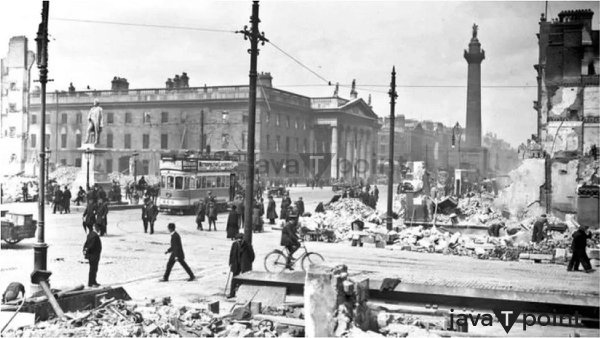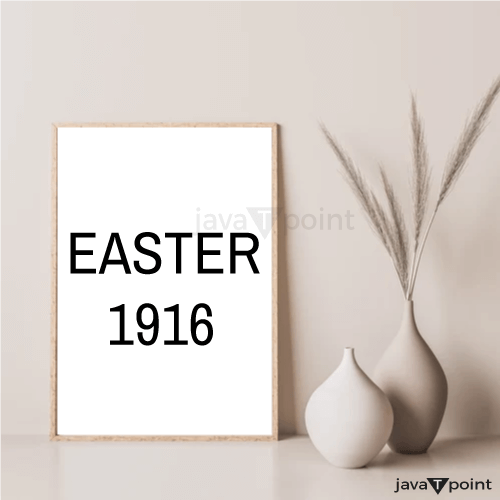Easter, 1916 summary
|
| Written by | William Butler Yeats (1916) |
| Published in | Michael Robartes and the Dancer (1921) |
| Genre | Romantic poetry, political poetry, Lyric poetry, modernism |
| Rhyme scheme | Alternating rhyming lines in ABAB form |
| Poetic devices | Oxymoron, refrain, irony, Pastoral metaphor, juxtaposition, metonymy, metaphor. |
| Notable Imagery | Nature, architecture in Dublin, stone, battling/horses |
| Tone | Elegiac, ambivalent, mournful, considering |
| Key Themes | Immortality, nature of heroism, elegy |
| Meaning | The poet has examined heroism and immortality through the lens of everyday life in Ireland. The poet's notification commemorates the lives lost at the Easter uprising in 1916 Dublin. Depict about the immortal critical leaders in the movement, personally known by Yeats. |
About the poet
Name: William Butler Yeats (W B Yeats)
Birth: In 1865, at Sandymount in Country Dublin, Ireland
Death: In 1939, at the age of 73
About the poet: The poet was fascinated with Irish legends and the occult at an early age, which brought his interest in poetry. He was an important figure of the 20th century as its earliest publication was in 1889 though he had written poetry before that. He was a part of the Irish Revolution through his poetry and was also responsible for the revival of Irish literature with many others. His famous work has 'When You Are Old,' 'A Dialogue of Self and Soul,' and 'Her Anxiety.' W.B. Yeats received Noble Prize in Literature in 1923 because of his versatile writing and the different forms of his poems
Summary

Initially, the poem describes everyday life (routine and mundane life of the people) in Dublin when the British hold their freedom due to World War I. The poet says that he met people who came from work at a counter or desk with vivid faces in the evening. Poets met these people in 18th-century houses in Dublin, and the poet's response was nodding off the head or exchanging meaning fewer words during the conversation (tried by the poet himself). People and poets met at a club and sat around the fire at the club, where they told mocking stories or jokes about the Irish people. Poet could do that because he and the people he talked to belonged to the same land ruled by Englishmen and considered the land of clowns. But all things have changed completely; the beauty that comes out is terrible because it arose from the birth of death of so many Irish revolutionaries.
In the second stanza, the poet describes other rebel people silently participating in the uprising whose daily routine was affected by the revolution. He pointed to Constance Markiewicz, an ignorant woman who spent her time lobbying to bring positive change to Ireland. When the woman was young and beautiful, she used to ride a horse as a part of the riding team; her voice was lovely at that time compared to her shill voice now due to arguing for long hours continuously. A man named Patrick Pearse ran a school and parallelly wrote poetry (rode of the winged horse of poetry). His friend and helper (Thomas MacDonagh: a poet and critic) also joined his force and won fame due to his sensitivity. Another man named John Mac Bride (a drunken and boastful fellow) has done wrong to the people close to the poet's heart, and he had a wife named Maude Gonne. All these Irish people were playing their roles in this casual comedy, but now they have resigned from this comedy role as if they are dead now. This transformed beauty is terrible because it is made of sacrifices of these people's lives
The third paragraph tells that all these people's hearts are united with a single purpose, but now they don't have trouble living streams as they are buried under their graves. Being buried, their hurts will remain enacted to a stone To trouble the stream, whether it's summer or winter. Everything around the stone can change, including the horse with a rider on it coming from the road, birds that fly from one cloud to another, the hoof of the horse slides onto the bank of the stream and splashing the water in the river, the long-legged moorhens that dive and give calls to moor- cocks. Everything can change minute by minute, but this stone stays during all these living activities.
In the fourth stanza, the stone imagery describes the hard-heartedness of people who became too passionate about this revolution. Poet said enough of these sacrifices. Now they are not needed; it was heaven's part. We can murmur the names of the martyrs one by one who died just like a mother would watch after a child or the limbs of a child named by a mother so that sleep may come to the child's limbs. This martyr's death was not nightfall; it was death, a needless death that hasn't achieved any results. After this revolution, England remains in power in Ireland. The dream of a martyr couldn't be achieved, but these people cherish their dream and lay down their lives to live up to that dream. No one knows what was in their mind, whether it's an excess of love or something else that kept them puzzled till death. The best tribute port can pay to them is by writing out their names in verse - Connolly & Pearse, MacDonagh & Macbride. Their sacrifices have changed everything, not only for the present but for all times to come, and created this terrible beauty (it involves the death of people rather than their attempt being doomed to failure from the start).
So, the uprising of Easter affects the poet (Yeats) in an exciting manner that he can't reconcile. Yeats was overwhelmed by the news without an idea that a public movement could move so profoundly to him. In the poem, the first three sections look backward to a 'comic' world left behind, and the fourth stanza points toward the results of Irish revolutionaries. The second stanza depicts the detailed personalities of some of the revolutionaries before their destruction in the Easter Rising, and the third stanza sketches the image of the world subject to time and death.
Easter 1916 is one of the best poems in the collection of the poem by Yeats, with a variety of tones in different lines. Yeats use rhetorical syntax that plays off and contrasts 'artificial' with natural speech rhythms. This poem reflects the emotions, feelings, and nationalism of people toward their country that lead them to the graveyard but helpful in attaining freedom. The whole situation result is muted that remains with us, and is not easy to live with.
 For Videos Join Our Youtube Channel: Join Now
For Videos Join Our Youtube Channel: Join Now
Feedback
- Send your Feedback to [email protected]
Help Others, Please Share










